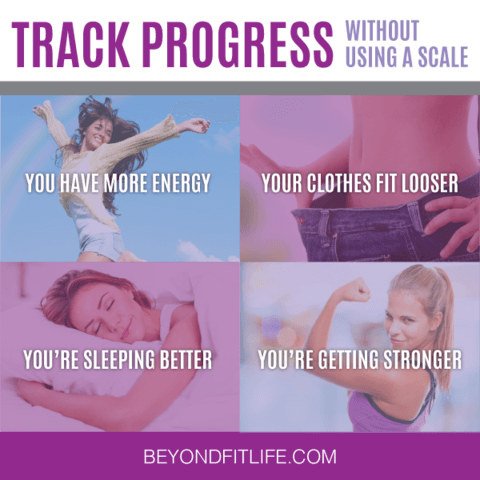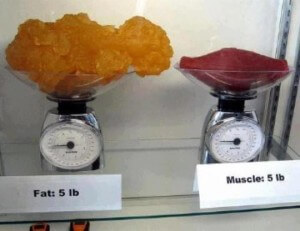Ditch the Scale!
I have touched upon this topic many times, but it is an important subject that I run into a lot – fat loss versus weight loss – and at the heart of this issue is the scale.
Many of us monitor our success through the scale. Whether we are trying to get into shape for the summer, or want to finally fit back into those pants from freshman year of college, we think the only way to gauge that is through the scale, and that is simply not true. I have several pairs of pants from college that fit me now at over ten pounds heavier than I was then, because I have built a lot more muscle than what I had in college. Do I have the “perfect” body? Probably not to a lot of people based on physical appearance, but I do have a body that is capable of doing everyday tasks, so it is ideal for me. BUT, the scale does not tell me that.
Weight loss is nice on the surface, because you see a number on the scale going down and that validates your work from the previous day or week. That is not the whole picture though. When you only lose weight, it can be from a variety of other things including muscle loss, or dehydration. When you lose muscle or become dehydrated, your body is not functioning at its optimum level. The scale does not inform as to why weight drops.
And what happens when that number is not dropping? Does that mean that all of those hours on the elliptical and all of those days spent eating the same meals, totaling 1000 calories for the day, was for nothing? (Please note this is sarcastic, and I do not ever recommend this!) The scale not dipping could be due to a million things such as: bloating (for women, hey hormones!), insufficient calorie supply causing your body to go into starvation mode and retain fat, building muscle (this is a good thing!), or because your body is at a healthy weight.
People say muscle weighs more than fat. The fact is, a pound is a pound, but a pound of muscle takes up less space and burns more calories at rest than a pound of fat. Therefore, when you are lifting heavy weights, you will begin to build muscle and may notice the scale isn’t changing, or even going up, yet your clothes are fitting. That is great! That means you are building a healthy body that is capable of lifting things up and putting them down.
Ladies, you will not get big because you are lifting and building muscle. You will only get big when you are over consuming crappy, processed food. Women do not have enough testosterone to bulk up the way men can. I have had one female client, out of over 100s of women I have worked with, who felt she built muscle at a greater rate than she burned fat. Due to that, she gave up after only two months, when in reality, a few tweaks in her diet could have changed that.
The scale is not a measure of success or self-worth. Out of all of the measurements one can take to monitor their progress, the scale is the least accurate. If you feel compelled to monitor your goals with a number, why not use a tape measure to see the inches shedding everywhere, or a body fat monitor to watch your body fat percentage drop? Or better yet, set workout goals (such as lifting a heavier weight, running a faster pace, or achieving a new yoga pose) and use those as your barometer? Clothes are usually a great indicator of success, as are progress pictures. All of these are more accurate than the number on the scale at indicating your success.
I asked five of my friends, who all workout and have very different approaches to exercise, the following questions:
What is your favorite exercise/workout and why?
Do you workout to reach a specific goal (if so what is that goal) or do you workout for health (or both)?
The main thing I took away from their responses is that whatever form of exercise they enjoy, it is partially because it reduces stress. It is scientifically proven that exercise relieves stress, so why are we still weighing ourselves? And although a few had other goals as well, they all workout for their overall health. The scale does not reflect health. Toss the scale.
Here’s what they said:
K: “I love running for the endorphins, peace and it is relaxing for me. I used to run to reach a goal but now I do it more for health/sanity. I like bootcamp/crossfit type workouts for the push, competition and “full body workout feel.” I usually do these workouts for health purposes – to work all the muscles.
A: My favorite exercises are yoga and swimming because they are both low impact and help clear my mind. For a good sweat or when I’m having a bad day, I really enjoy kickboxing. There’s nothing better than jumping around to good music while picturing kicking the crap out of somebody! When all else fails, I make sure I get a good walk once a day with my dog. To me, walking is one of those great “I’m exercising even though I don’t think I’m exercising” activities. I exercise because I don’t like how my body feels when I don’t. It makes me happier, helps relieve stress, I eat better when I exercise and I’m in an all around better mood. Seems like the ultimate medicine to me!
C: My favorite right now is doing T25 and insanity. However, I would say in those programs my favorite thing is the cardio days. I prefer the cardio because of the rush during and after. Also, I feel like I push myself more during cardio. I workout for both reasons. My goal is just to be more comfortable with myself and in hopes to permanently maintain a healthier lifestyle.
J: Favorite exercises are boot camp because it covers cardio and strength training and it’s always different. I’ve gotten really good results in terms of endurance and muscle/strength definition. Cardio boxing: I hate it while I’m doing it but I love the stress relief; and yoga because this challenges strength in a different way and brings me some calm. I workout for health. I did join a bootcamp challenge as I noticed my pants becoming tighter but my overall reason is to maintain my health.
R: It’s hard to say which is a favorite because the few I will mention as a “top 3” are all important in different aspects. I’d have to start off by saying running because it gets me the most sweaty and I can really tell I’ve worked hard getting my heart rate up and making my muscles stronger. It’s also such an individual and mental workout and you have full control of what you do and how you do, so I love running. With that said, I think it’s just as important to strengthen muscles and not just work on cardio. A great way to get an all around workout plus some cardio is bootcamp. This got me really into strength training for all over my body, not just the basic few over and over again, adding in spirits of cardio that wasn’t running. To balance everything out, I love a good yoga class!
I work out mainly for my health. To be healthy and stay healthy. When I started bootcamp the intention was to become more healthy and active and try something different. With it came weight loss and strength, and feeling better overall, thus I want to maintain my healthy workouts and thus the cycle begins. But really it’s to be healthy.
A word from Kate
If you’ve been following me for awhile then you know that I’m not a big fan of using the scale by itself for tracking progress. If I had only been using the scale to monitor my progress, I would have given up before I had given my body an opportunity to truly change.
Throughout my transformation, the scale actually went UP in weight.
It was unable to measure all of the physical changes that were occurring with my body composition, so I had to rely on other methods for feedback.
Judging your progress using your body weight on the scale can be super frustrating at times due to the many different fluctuations are happening in your body on a daily basis.
These scale and weight fluctuations can be caused by lots of different things, including:
1. Hormones
2. Sodium intake
3. Water intake
4. Carbohydrate intake
5. Energy expenditure
6. Inflammation from training
7. Digestion
8. Time of day
Non-Scale Ways to Measure Progress
Here are four ways that you can easily track and identify progress as a result of your healthy habits:
1. Get your Percent Body Fat Measured: The scale doesn’t tell the whole story about you – body composition is more important than just a non-discriminatory number. Muscle is more dense and thus weighs more per square inch than fat does! Even if you may not weigh much, you might be low in lean tissue and high in adipose (which predisposes you to all sorts of health complications and drastically decreases your metabolic potential). It’s very important to know your numbers.
2. Check Yourself – How do you feel?: Are you feeling more energized? Are you feeling more in tune with your body and its needs? Are you noticing how your body responds to certain foods (positively or negatively) and adjusting your habits accordingly? Are you feeling off when you aren’t keeping up with your exercise routine? Are your blood work results from the Doctor improved? All of these and more are signs of progress! Other ideas include:
- You notice yourself having more energy. You’re not falling asleep at your desk and you’re energized for your workouts or chasing your kids.
- Your clothes begin to feel different. You’re no longer squeezing into those shorts you wore last summer.
- You’re sleeping better.
- You’re getting increasingly stronger in your workouts week to week.
3. Photographic Evidence: Take pictures at your “start date” and then take a progress photo every month. Be sure you’re wearing the exact same outfit so you can really see how much you’ve changed. Take photos with you standing at different angles – front, each side, and back. Feeling super spiffy the day you take your progress photos? Strike a fun pose in an extra pic! Soon you’ll be looking back at those “before” pictures in shock about how far you’ve come. See some awesome examples of before/after pictures.
4. Barometer Pants: Use the fit of your clothes to determine progress. Consistency and adherence to healthy habits (like doing your BeyondFit Life Workouts) will lead to sustainable body change. Suddenly you’ll notice those pants are fitting a little looser. That might be one of the best indicators of all of your progress!

Circumference Measurements
Another great way to track your progress is via circumference measurements.
Here’s a guideline for taking starting circumference measurements:
Chest – at nipple
Bicep – halfway between shoulder & elbow
Thigh – halfway between hip and knee
Hips – widest part (turn to side for this measurement)
Waist – at belly button (that way no matter what changes, we’re always measuring at the same spot!)
I recommend updating these measurements once/month.
Kristen is a NASM educated Certified Personal Trainer, Fitness Nutrition Specialist, & Women’s Fitness Specialist. She loves running, lifting and pretty much all exercise, and nutrition, which she is excited to utilize as a means to help others. Connect with Kristen to find advice on exercise, recipes, and tribulations I encounter in my own training and life!

